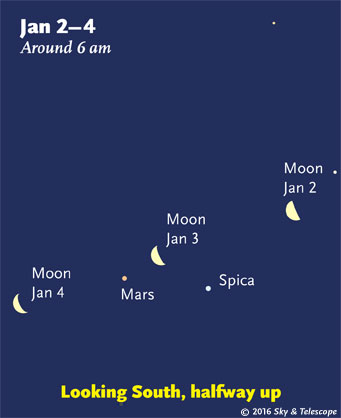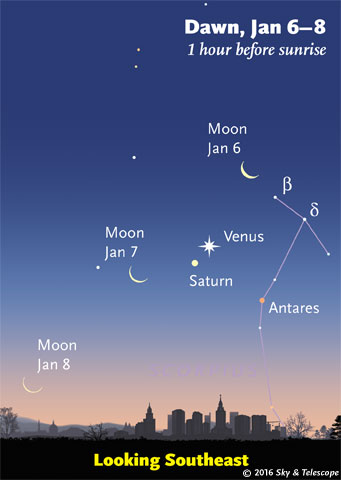This Week’s Sky at a Glance, January 1 – 9
Comet Catalina (C/2013 US10) remains about 6th magnitude, very high in the southeast before the first light of dawn. It's unlikely to brighten much further. See the December Sky & Telescope, page 45, or Bob King's article online. Both provide finder charts.
________________________

Catch Mercury in the evening twilight early this week, while you still can. Altair helps point the way.

The waning Moon poses between Spica and Mars early in the dawn of Sunday the 3rd.
Friday, January 1
• Orion season is in full swing. The Hunter strides up the southeastern sky in the evening, with his three-star belt still almost vertical. Far below shines brilliant Sirius, the Dog Star, in Canis Major.
• By midevening at this time of year, the Great Square of Pegasus balances on one corner high in the west. The vast Andromeda-Pegasus constellation complex runs all the way from near the zenith (Andromeda's foot) down through the Great Square (Pegasus's body) to somewhat low in the west (Pegasus's nose).
• Late tonight, telescope users along a track from southern Georgia to San Diego can watch for an 8.8-magnitude star high in the feet of Gemini to be occulted by the invisibly faint asteroid 1173 Anchises for up to 7 seconds. Map, times, finder charts
Saturday, January 2
• Dawn and sunrise happen at their latest for the year this week (in the world's mid-northern latitudes). Early in the dawn, look low in the southeast for bright Venus. It heads up a triangle with Saturn to its lower left and twinkly Antares lower down. And on Sunday morning the 3rd, the Moon high to Venus's upper right shines with Mars and Spica, as shown at right.
• Earth is at perihelion today, its closest to the Sun for the year: only 1 part in 30 closer than at aphelion in July.
Sunday, January 3
• The Quadrantid meteor shower, brief but sometimes rich, is well timed this year for North America. It should reach its peak for several hours late tonight. See our article in the January Sky & Telescope, page 48.
Monday, January 4
• Vega is still moderately high in the northwest when the stars come out. Once the night is fully dark, the little constellation figure of Lyra, so high on warm summer nights, extends leftward from Vega low in the cold.

Venus and Saturn draw closer together in the eastern dawn as the waning crescent Moon passes them by. . .

. . .and then on the morning of the 9th, Venus and Saturn have their conjunction.
Tuesday, January 5
• Latest sunrise for the year (if you're near 40° north latitude). Tomorrow morning the 6th, the waning Moon stands above Venus, Saturn, and Antares, as shown here.
Wednesday, January 6
• On Thursday morning the 7th, the waning crescent Moon stands left of Venus, Saturn, and Antares low in the southeast, as shown here.
• Algol should be at its minimum light, magnitude 3.4 instead of its usual 2.1, for a couple hours centered on 10:31 p.m. EST.
Thursday, January 7
• Before moonlight returns to the evening sky next week, explore some new sights in upper Eridanus with your scope — using Sue French's Deep-Sky Wonders column, chart, and photos in the January Sky & Telescope, page 55. Do you know about the row of three 12th-magnitude galaxies in the field of Nu Eridani?
And take apart famous NGC 1356 in Eridanus, "the definitive barred spiral galaxy," with Going Deep on page 58 of the January issue.
Friday, January 8
• In the early dawn Saturday morning, spot brilliant Venus, the "Morning Star," in the southeast. Right next to it is Saturn, only 1/60 as bright. When seen from the Americas, they'll be 1/2° or less apart. That's about the width of a chopstick at arm's length. Binoculars give a fine view, and both planets will fit into a telescope's low- or medium-power eyepiece.
They'll be at their very closest, a mere 0.1° apart, around 4h Universal Time: excellent timing for Europe.
Saturday, January 9
• In this very coldest time of the year, the dim Little Dipper (Ursa Minor) hangs straight down from Polaris after dinnertime, as if (per Leslie Peltier) from a nail on the cold north wall of the sky.
The Big Dipper, meanwhile, is creeping up low in the north-northeast. Its handle is very low and its bowl is to the upper right.
• Algol should be at minimum light for a couple hours centered on 7:20 p.m. EST.
No comments:
Post a Comment